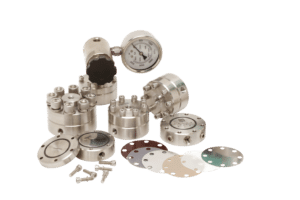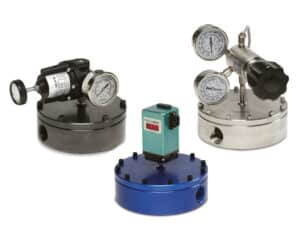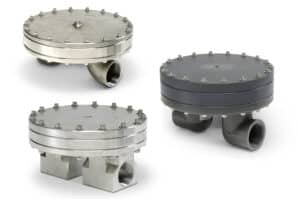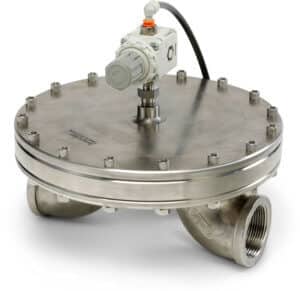Equilibar® Back Pressure Regulators – Overview

Equilibar® Research Series
Cv range: 0 to 0.6
Max temperature: 450°C
Max pressure: 690 barg (10.000 PSI)

Pilot Plant | Equilibar® GS Series
Cv range: 1·E-03 to 8.50
Max temperature: 300°C
Max pressure: 206 barg (3000 PSI)

Industrial | Equilibar® BD-Series
Cv range: 0.1 to 160
Max temperature: 300°C
Max pressure: 10 barg (150 PSI)

Food, Beverages & Hygiene | Equilibar® FD Series
Cv range: 1·E-7…19
Max temperature: 150 °C
Max pressure: 10 barg (150 PSI)

Vacuum Regulators | Equilibar® EVR Series
Cv range: 1·E-03 to 60
Max temperature: 60°C
Max pressure: 0 to -990 mbar
Equilibar Back Pressure Regulators: Patented technology for excellent control
Equilibar back pressure regulators maintain the upstream pressure at their own inlet. The patented technology enables highly accurate and stable process control. It is particularly suitable for demanding process conditions, such as low flow, extreme temperature, mixed-phase fluids, corrosive media, or sanitary process conditions. The performance of the Equilibar back pressure regulator is unparalleled in the industry!
Read more about the unique operating principle of these innovative control valves in How it works.
Control valve or (electronic) back pressure regulator?
Although the Equilibar BPR is undoubtedly a ‘control valve’, and PCS often supplies these instruments for customer applications to control process parameters other than (back) pressure (see our Expertise area), we prefer to call them ‘back pressure regulators’. We use the terms ‘back pressure regulator’ and ‘control valve’ interchangeably though, or just ‘BPR’ for short.
Key features of Equilibar back pressure regulating valves
Back pressure regulating valves are used in a wide variety of applications. Inside our units you can see its straightforward construction. Between the main body and the reference cap a diaphragm, sealed by two O-rings, is placed. The regulator is then placed downstream of a process to keep its pressure constant. The back pressure regulating valves operate at extreme precision, with fast response and are even capable of regulating two phase flows.
Equilibar's unique dome-loaded and multi-orifice back pressure regulators work by a remarkable force balance on a flexible diaphragm between three different pressures. The lower pressure at the outlet attempts to hold the diaphragm in a leak-tight seal with the orifice. A slight excess between the fluid inlet pressure and the reference pressure rapidly overwhelms these seating forces and lifts the diaphragm off the orifices.
The result is an incredibly fast response, maintaining the inlet pressure in a tight equilibrium with the pressure set at the reference. When the pressure at the inlet exceeds the pressure set at the reference, the valve will open to relieve pressure. Equilibar back pressure regulators control the inlet pressure (upstream) by opening up just enough to hold back the wanted inlet pressure (upstream). Learn more about this effective operating principle on the How it works page.
Learn how we apply the back pressure regulator for the control of pressure as well as other process parameters in our Expertise area.
The accuracy and precision of Equilibar control valves is a benefit that users can rely on: In most applications, the instrument's inlet pressure matches the reference pressure within 1-2% across a wide flow range; in many research applications this is even 0.5% or better!
Equilibar back pressure regulators outperform other designs in applications with e.g. low flow rates, mixed-phase fluids, corrosive media, or extreme temperatures. The Equilibar back pressure regulator provides unmatched stability through flow rate ranges as wide as 1.000:1 and 100.000:1!
In practice, the conditions under which a future (experimental) process will operate are often unknown when preparing to build such an application. Equilibar back pressure regulators can be operated with large variations in design specifications and therefore enable very broad process parameters.
In this context, it is useful to take a closer look at one of the challenges of stable back pressure control: The influence of the upstream pressure on the sizing of the regulator. Applications with a constant inlet pressure upstream of the valve often use traditional valves. As soon as the downstream pressure is less than 45% of the inlet pressure, the (traditional plug and seat) valve becomes overcritical and has no impact anymore. For our back pressure regulators, this is different: In back pressure mode, the valve needs to vary the inlet pressure. A large Cv range is often needed in such cases. And in more specific cases, also flow rate and media properties are variables. Traditional valves can’t always offer the desired Cv rangeability with so many variables (read more below about the comparison of our back pressure regulators against more traditional valves).
Equilibar back pressure regulators are valves especially developed for this purpose: They offer a 1:100.000 Cv rangeability due to the multiple orifice design and therefore enable single-valve-solutions covering the whole range. Equilibar back pressure regulators can also handle variable flow rates, media properties like changing density and viscosity over a wide range of temperatures.
There are different product lines for different fields of application:
- The Research Series is designed for use in research settings and comes in different variations for zero flow, ultra low flow, low flow, and high flow as well as high temperatures.
- The BR series is blockage resistant and thus specifically suitable for use with super-critical media.
- The GS series is intended for use in pilot plant size applications.
- The BD series with its different line sizes can be used for industrial applications.
- FD series is specific for sanitary applications, like the Food & Beverage industry and other hygiene-sensitive applications.
- Last in this list — the EVR series focuses on vacuum applications.
On our Applications page, we list more examples of customer applications using our back pressure regulators and electronic pressure controllers.
Equilibar BPR's are compatible with most aggressive media, can handle two-phase flow, and are fairly easy to disassemble, clean, and re-build. All this results in an instrument that is easy to work with and that helps you to minimize process disruptions and improve process outcomes.
The precision of the Equilibar back pressure regulator is primarily limited by the accuracy of the reference set-point on the dome. You can apply the reference set-point pressure by a manual forward pressure reducing regulator or with an electronic pressure controller (single valve or dual valve). Electronic regulators provide the most flexibility and the most accurate result.
In sophisticated pilot plant and R&D processes where you require maximum performance, stability, accuracy, and reproducibility, we recommend closed-loop control between the actual process pressure and the reference pressure. Contact us for more information on closed-loop control.
Available in a wide range of materials and sizes. Explore all options in our Configurator tool or read our Spare Parts & Maintenance section.

